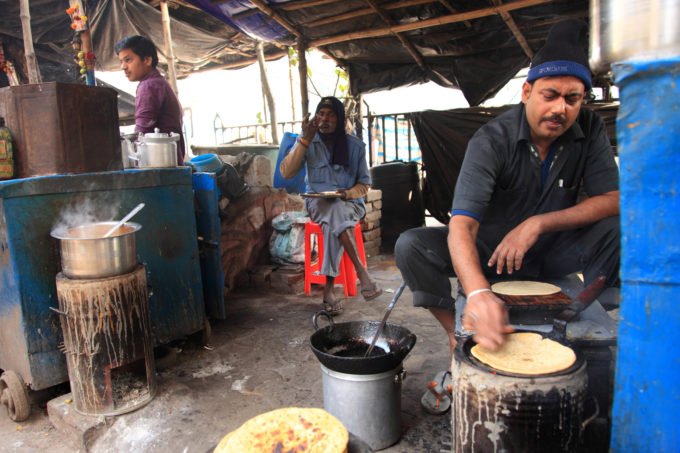
In Defense of Using Your Hands in the Kitchen

The best tool in the kitchen is something you don’t have to pay a penny for.
This post originally appeared on March 23, 2018, in Anup Kaphle’s weekly newsletter. Read the archives and subscribe to the newsletter.
Hello friends, thank God it’s Friday!
What’s the most expensive kitchen appliance you’ve ever bought for yourself? Oven ranges and refrigerators don’t count. Maybe a Nespresso or a Barista Express? Or a hydraulic juicer? Here’s one you may not have heard of: a robot that prints you dozens of hot, perfectly round roti. After eight years of research and development, a Singaporean couple introduced “Rotimatic” last year for an “attractive” price tag of $999. Well, our intrepid roti correspondent Burhan Warzi tried it, and the verdict is in: you may grind your coffee in a machine, and your soups in a processor, but roti must always be made by hand.
I’m a believer in the whole do-it-with-your-hands mantra in the kitchen. In fact, I believe the best tool in the kitchen is something you don’t have to pay a penny for. But it isn’t really about saving money here: it’s about connecting yourself with the food you’re making. And for people like Burhan, who tried the roti robot, and myself, the act of using our hands to prepare a dish the same way we grew up eating it is the ultimate reward. A few years ago when I went home, I picked up what seemed like the most idiotic thing to bring back to the United States—a 13-pound flat stone that my parents had been using for nearly two decades as a hand grinder.
“Why wouldn’t you buy one of those electric spice grinders,” my father asked. I didn’t have a right answer. The idea of spending ten times more effort and time to do the same thing somehow felt deeply satisfying. At the airline counter, my suitcase was deemed overweight by quite a bit. The lady who was checking me in suggested I remove the stone. No way! Instead, I paid $65 in excess baggage fees that day for a stone my parents must have spent less than a few dollars. Now, this stone, which I use nearly every day to grind soaked cumin and coriander, dried chilies and garlic, is one of the most expensive kitchen appliances I own.
You’re probably thinking that’s the craziest thing you’ve heard today. I have something better. A prominent Orthodox rabbi in Israel has decided that Jews can eat pork—as long as the meat comes from a genetically cloned pig. He also suggests it with a side of milk.
If cloned meat is not your jam, I suggest we go across the Mediterranean to Malta, where you don’t have to eat cloned anything. Our Maltese expert suggests going straight for the rabbit stew, the undisputed national dish of the islands.
Here’s what else I thought was fascinating this week.
- How the ‘Doomsday Vault’ protects Earth’s food supply: The one place that is supposed to be a doomsday backup for civilization—a vault that holds 930,000 seed samples for 5,000 different plant species—is being retooled after the entrance to the vault sprang a leak last year. The Norwegian government, which oversees the vault, is spending north of $10 million on insulating it better so it can withstand the effects of climate change. In 2015, researchers in Syria asked to withdraw nearly 50,000 seed samples from the vault to replace seeds in the gene bank near the war-ravaged city of Aleppo—all of which was returned to the Norwegian vault last year.
- Meet the man who couldn’t stop eating: Once upon a time in France, a young man gained notoriety for eating everything, including corks, stones, garbage, a live cat (he didn’t eat the bones and vomited the fur later), a whole eel, and garbage. By the age of 17, he could consume his entire body weight in food in a single day. He ate so much that his own family couldn’t afford to feed him, so they kicked him out of the house. That’s when he turned this bizarre habit into performance art, eating a massive amount of food (and not food) in front of an audience riveted by his appetite. After a brief stint with the military and a subject of medical study, he met a tragic end.
Before I take off, can I tell you what I plan to make this weekend? Perhaps you should make it, too. This Dan Dan Noodles, laced with smoky chili oil and fiery Sichuan peppers. If the chili feels overbearing, I’ll do what the rabbi ordered—pair it with a glass of milk.
Please follow us on Facebook and tell us what you think about our stories. We’d also be thrilled if you follow us on Instagram, where this week, photojournalist Bradley Secker is sharing his images from Istanbul and elsewhere.
Sign up for R&K Insider, our collection of the most compelling happenings in food, politics, and travel from across the web.
Top photo by: AJP/Shutterstock.com